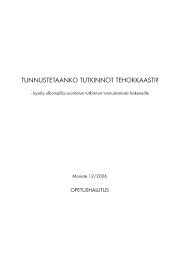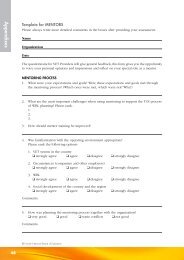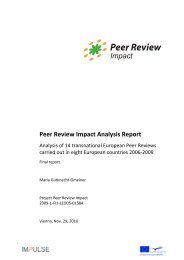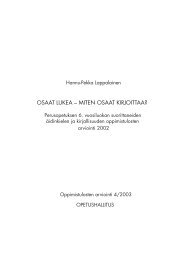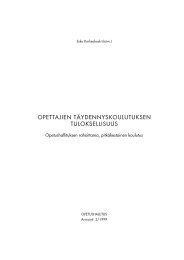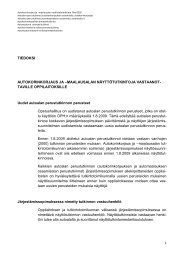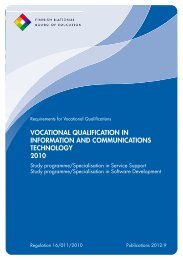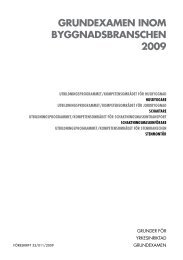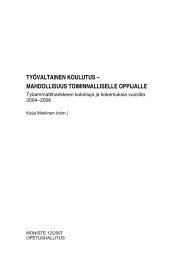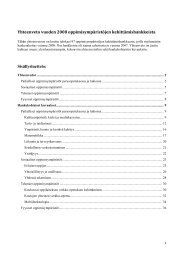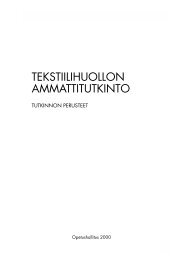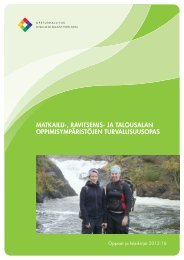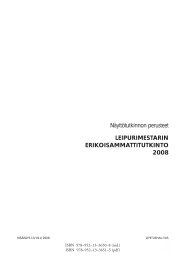PREPARATORY INSTRUCTION AND GUIDANCE
PREPARATORY INSTRUCTION AND GUIDANCE
PREPARATORY INSTRUCTION AND GUIDANCE
You also want an ePaper? Increase the reach of your titles
YUMPU automatically turns print PDFs into web optimized ePapers that Google loves.
<strong>PREPARATORY</strong><br />
<strong>INSTRUCTION</strong><br />
<strong>AND</strong> <strong>GUIDANCE</strong>
Preparatory instruction and guidance<br />
Preparatory instruction helps students to improve their studying skills and prepares them for taking a vocational<br />
qualification. It takes place between basic education and upper secondary vocational education and<br />
training. Preparatory instruction is organised in connection with other upper secondary education and training,<br />
but the students do not obtain a qualification. A certificate is issued for completed instruction.<br />
Preparatory instruction is implemented according to the National Core Curriculum confirmed by the National<br />
Board of Education, but the application of the curriculum has scope for individualisation and flexibility. The<br />
basis for determining a student’s personal goals and the guidance and support he/she needs is recognition of<br />
competence. The aim of accreditation for prior learning, on the other hand, is to avoid overlapping studies.<br />
Students who have completed preparatory instruction are awarded additional points in the joint application<br />
system. Any vocational studies taken during preparatory instruction and guidance can be recognized and accredited<br />
as part of a vocational qualification obtained later.<br />
Preparatory instruction does not give the student general eligibility for studies in higher education, however,<br />
as the requirement for eligibility is obtaining a vocational qualification.<br />
Preparatory instruction and guidance<br />
• preparatory instruction and guidance for vocational education and training<br />
• home economics instruction<br />
• preparatory education for immigrants<br />
• rehabilitative instruction and guidance for the disabled
Preparatory instruction<br />
and guidance for<br />
vocational education and<br />
training (Ammattistartti)<br />
Aim of the instruction:<br />
The aim of this instruction is to improve the<br />
student’s capacity to obtain a place in vocational<br />
upper secondary education and training<br />
and to get acquainted with a wide range<br />
of various fields of education, vocations and<br />
jobs. He/she may improve his/her capacities<br />
for studying and build the knowledge<br />
base needed in the studies. The instruction<br />
helps the students with their career choices<br />
and plans, and guides them to develop into<br />
active members of society. After the instruction,<br />
the students will have plans for where<br />
to go next.<br />
For whom is the instruction suitable<br />
Ammattistartti is aimed at those young people<br />
who have completed comprehensive<br />
school and who<br />
• have not yet made a decision about their<br />
career choice<br />
• want to try out various fields of upper<br />
secondary vocational education and<br />
training before making a final decision<br />
• want to improve their studying skills<br />
• need to expand their knowledge base<br />
• have been left without a place in further<br />
studies.<br />
4
The instruction is primarily intended for<br />
those coming directly from basic education,<br />
but persons who have dropped out of vocational<br />
or general upper secondary studies<br />
in an early phase may also be accepted as<br />
students.<br />
Scope of the instruction:<br />
The scope of this instruction is 20-40 credits,<br />
and it takes from six months to a year. The<br />
majority of students study for 40 credits.<br />
Contents of the instruction:<br />
As compulsory studies (15–40 credits), Ammattistartti<br />
teaches studying and life skills,<br />
builds basic knowledge and skills (if they<br />
wish, the students can improve the grades<br />
of their basic education certificate) and<br />
career choice and planning skills (getting<br />
acquainted with vocations, education and<br />
training and working life, training for on-thejob<br />
learning). Optional studies (0-15 credits)<br />
comprise vocational and other optional studies.<br />
Essential principles of implementing<br />
the instruction include<br />
• individuality: each student draws up an<br />
individual study plan with his/her teacher<br />
and receives plenty of guidance and<br />
support<br />
• flexibility: the student may apply for and<br />
change over to education and training<br />
leading to a qualification in the middle<br />
of the academic term, should a place be<br />
offered<br />
• practical and activity-oriented studies<br />
• vocational orientation: the instruction is<br />
oriented towards vocational education<br />
and training, and it can be more specifically<br />
focused on certain fields or qualifications;<br />
it is possible to take vocational<br />
studies in the course of the instruction<br />
that can later be accredited as part of a<br />
vocational qualification.<br />
Opportunities for Further Study<br />
The aim is for the student to have a plan for continuing<br />
his/her studies after Ammattistartti. A student<br />
who has completed this instruction can apply for a<br />
place in vocational upper secondary education and<br />
training (as a competence-based qualification or<br />
apprenticeship training) or go on to other types of<br />
education or training.<br />
5
6<br />
Home economics<br />
instruction<br />
Aim of the instruction:<br />
This instruction imparts practical information<br />
and skills for managing your everyday<br />
life and your household. It teaches the students<br />
to plan and manage their households<br />
economically, ecologically and ethically. In<br />
addition, the instruction promotes wellbeing<br />
and teaches the students to ensure the<br />
safety and health of their environment and<br />
to make it attractive.<br />
For whom is the instruction suitable<br />
The instruction is suitable for all those interested<br />
in managing a household as well<br />
as adults and young people in various life<br />
stages and situations. The instruction also<br />
coaches the students in applying for further<br />
studies.<br />
Scope of the instruction:<br />
The scope of the home economics instruction<br />
is 20 credits.<br />
Contents of the instruction:<br />
The instruction consists of compulsory<br />
studies (15 credits) and optional studies (5<br />
credits). The compulsory studies cover issues<br />
relevant to keeping a house and the<br />
student’s living environment, preparing<br />
home-made meals and maintaining a home.<br />
Optional studies can be individually selected,<br />
and they may include areas such as<br />
child care, exercise, plantscaping, organising<br />
parties, languages or career choice issues.<br />
The studies may also incorporate content<br />
from other preparatory instruction and training<br />
or vocational upper secondary education<br />
and training.<br />
The studies are practical and activity-oriented.<br />
The instruction can be focused on a<br />
specific field.<br />
Opportunities for Further Study<br />
After this instruction, the student will<br />
be able to move on to vocational upper<br />
secondary education or training or<br />
other further studies. The candidates are<br />
awarded additional points for completing<br />
household economics studies when applying<br />
for education and training leading<br />
to a vocational qualification. The instruction<br />
also provides a good foundation for<br />
education and training in the tourism and<br />
catering sector and social services and<br />
health care. The instruction may also facilitate<br />
finding employment as an au pair<br />
or in other assisting tasks.
7<br />
7
Preparatory education for<br />
immigrants<br />
Aim of the instruction:<br />
The aim of the instruction is to improve<br />
language and other skills needed for moving<br />
on to vocational upper secondary studies.<br />
The student receives basic capacities to<br />
study in vocational upper secondary education<br />
and training, becomes acquainted with<br />
the Finnish education and working culture,<br />
and builds his/her capacities to attend to<br />
teaching and cope with vocational upper<br />
secondary education and training leading to<br />
a qualification.<br />
For whom is the instruction suitable<br />
This instruction is suitable for immigrants<br />
or persons with an immigrant background<br />
whose basic linguistic skills in Finnish/<br />
Swedish correspond with the description of<br />
language skills level A2.2 (developing basic<br />
linguistic skills) before preparatory instruction.<br />
Scope of the instruction:<br />
The scope of this instruction is 20-40 credits,<br />
and it takes from six months to a year. The<br />
majority of providers offer this instruction in<br />
the scope of 40 credits.<br />
8
Contents of the instruction:<br />
The students study Finnish or Swedish,<br />
mathematics, information technology, natural<br />
sciences, civics and cultural knowledge,<br />
and they build up skills in studying and<br />
making career choices. The studies include<br />
optional studies and getting acquainted with<br />
various vocations and vocational studies.<br />
The skills in studying and making career<br />
choices also include training for on-the-job<br />
learning. The instruction prepares the students<br />
for all vocational upper secondary<br />
education and training in general, but it can<br />
be focused on specific fields.<br />
Level B1.2 (fluent basic linguistic skills) in<br />
the description of language skills mainly describes<br />
the student’s Finnish/Swedish skills<br />
at the end of the instruction.<br />
Opportunities for Further Study<br />
A person having completed this instruction<br />
may apply for vocational upper secondary<br />
education and training directed<br />
at both young people and adults and for<br />
apprenticeship training and, depending<br />
on his/her prior studies and work experience,<br />
through individualisation for<br />
education and training in preparation for<br />
further and specialist vocational qualifications.<br />
Students who have completed this<br />
instruction are awarded additional points<br />
in the joint application system.<br />
General:<br />
The students are eligible to receive normal<br />
student financial aid and a school transport<br />
subsidy. If preparatory instruction is part of<br />
an immigrant’s integration plan, he/she may<br />
receive immigration assistance instead of<br />
student financial aid. The instruction is not<br />
part of the joint application system. In other<br />
words, applications are addressed directly to<br />
the institutes of learning.<br />
9
Preparatory and<br />
rehabilitative education<br />
and guidance for<br />
disabled students<br />
Aim of the instruction:<br />
This instruction and guidance builds capacities<br />
for vocational upper secondary education<br />
and training, working and independent<br />
living, and provides help in clarifying future<br />
plans. It also supports the re-training of<br />
adult students who have become ill or disabled<br />
and supports their return to working<br />
life or education.<br />
For whom is the instruction suitable<br />
The instruction is suitable for a young<br />
person or adult needing particular support<br />
who, because of disability, illness or other<br />
reason, needs plenty of special support in<br />
his/her studies.<br />
Scope of the instruction:<br />
The scope of rehabilitative instruction and<br />
guidance aiming at vocational upper secondary<br />
education and training is mainly<br />
20-40 credits.<br />
The scope of instruction and guidance<br />
preparing for working and independent living<br />
and rehabilitation is 40-120 credits. The<br />
scope of the instruction is determined by<br />
the student’s individual goals and needs.<br />
10
Contents of the instruction:<br />
The studies of the student are composed<br />
based on his/her individual education plan,<br />
which starts from individual goals, needs<br />
and competence.<br />
Rehabilitative instruction and guidance aiming<br />
at vocational upper secondary education<br />
and training normally includes studies<br />
promoting capacities for studying and the<br />
ability to function, those supporting career<br />
choices and working life capacities and<br />
optional studies. In addition, the studies may<br />
contain field specific studies preparing the<br />
student for vocational studies or working<br />
life.<br />
Rehabilitative instruction and guidance<br />
aimed at working and independent living<br />
usually build up the student’s capacities for<br />
studying, the ability to function and working<br />
life capacities, and the student also takes<br />
optional studies.<br />
General:<br />
The aims of the instruction and the studies<br />
are flexibly determined by the student’s<br />
individual resources and his/her life situation.<br />
The teaching covers vocational special<br />
needs education. The student is supported<br />
in his/her studies by versatile and flexible<br />
teaching techniques, operating methods and<br />
learning environments. The studies are also<br />
supported by an exchange of information in<br />
the intersections of education, networking<br />
cooperation, making use of multiprofessional<br />
skills and co-operation between the home<br />
and the educational institutions. Rehabilitation<br />
is integrated in the studies, and it is<br />
implemented flexibly as part of the student’s<br />
learning and daily studies.<br />
Opportunities for Further Study<br />
Those who have completed this instruction<br />
mainly apply for vocational education<br />
and training with the aim of taking<br />
a qualification. Depending on their individual<br />
capacities, life situations and resources,<br />
the students may also continue<br />
their studies at other levels and forms of<br />
education, or the student can move on to<br />
working life after completing the studies.<br />
The aim is that after the instruction, the<br />
student will have as realistic an idea as<br />
possible of working life, various professions<br />
and education and training options.<br />
He/she will also have formed a picture of<br />
his/her capacities and needs for support,<br />
based on which he/she can assess and<br />
make up his/her own further vocational<br />
plans.<br />
For more information, visit:<br />
www.oph.fi<br />
www.koulutusnetti.fi<br />
www.ammattiosaaja.fi<br />
11
Finnish National Board<br />
of Education<br />
P.O. Box 380<br />
FI-00531 Helsinki<br />
Finland<br />
www.oph.fi/english<br />
Information Materials 2011:53 Photos: Olli Häkämies, Reima Virkkala, Antero Aaltonen & Färiborz Firuzabadi Layout: Matias Heinonen



